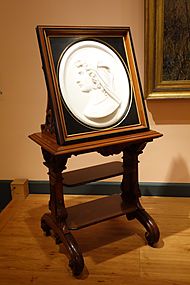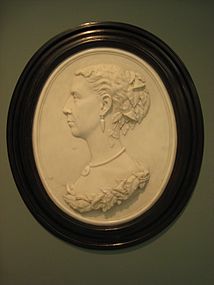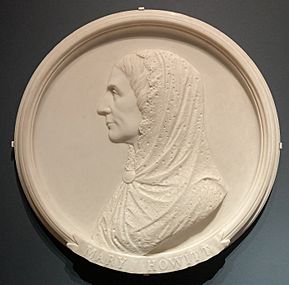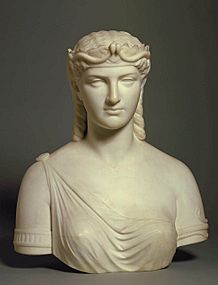Margaret Foley facts for kids
Quick facts for kids
Margaret Foley
|
|
|---|---|
| Born |
Margaret Foley
1827 Vermont, US
|
| Died | 1877 Merano, Austria-Hungary
|
| Nationality | American |
| Education | Self-taught |
| Known for | Sculpture, cameo, medallion, portraits, and direct carving |
|
Notable work
|
Cleopatra, 1876 Marble Relief of Pasuccia, 1865 Bronze Stonewall Jackson |
| Movement | Neoclassical sculpture |
Margaret E. Foley (born 1827, died 1877) was an American artist. She was known for making sculptures in a style called Neoclassical. Besides sculptures, she also made cameos, which are small carved artworks, and medallion portraits. She often carved directly into the material.
Contents
Early Life and Art Skills
Margaret Foley was born in Vermont, USA, in 1827. She grew up in the countryside near Vergennes. From a young age, she loved to carve wood. She taught herself to sculpt and became very good at it. Her father was a farm worker, so Margaret worked as a maid to pay for her schooling. Later, she became a schoolteacher.
When she was 14, Margaret moved to Lowell, Massachusetts. She worked in a spinning room at the Merrimack Corporation. Many young women, known as mill girls, worked in these factories.
While working at the mill, Margaret started carving cameos professionally. She carved them from shell and lava. She learned this skill at a special school for women. Cameo carving was seen as a good job for women artists. Margaret continued to make cameos to support herself throughout her career. She often received praise for her beautiful cameo work. In Lowell, she met Lorenza Haynes, and they remained close friends for almost 30 years.
Becoming a Sculptor in Rome
Moving to Rome
In 1860, a politician from Vermont saw Margaret's talent. With his help, she moved to Rome, Italy. She wanted to study art and become a better sculptor. She traveled with Charlotte Cushman and Emma Stebbins. These two women were important figures in a group of American women artists and thinkers living in Rome. Other famous sculptors in this group included Harriet Hosmer, Anne Whitney, and Edmonia Lewis.
When Margaret first arrived in Rome, she didn't have much money. But she soon found work making medallion portraits for important people. She also wrote about art for newspapers. At first, she shared a studio with Emma Stebbins. After getting some lessons from a sculptor named John Gibson, Margaret opened her own studio.
Creating Art for People
Margaret came from a working-class family. She didn't have rich people always supporting her art. So, she often chose subjects that tourists would want to buy. These included relief medallions, decorative pieces, and cameos. American and British tourists often visited her studio as part of their "Grand Tour" of Europe.
Like many other American women sculptors in Rome, Margaret carved her own marble. This helped her save money and make sure her art was exactly how she wanted it. Only Harriet Hosmer was successful enough to hire assistants for her studio.
Famous Sculptures
In Rome, Margaret began to create large marble medallion portraits. One example is her portrait of the poet William Cullen Bryant. She also made busts, which are sculptures of a person's head and shoulders. An example is her 1877 bust of the minister Theodore Parker.
One of her most famous medallions, made in 1866, showed a beautiful model from Naples named Pascuccia. This sculpture, called Marble Relief of Pasuccia, showed the mix of cultures in Rome at that time. Margaret sold at least four copies of this artwork.
Margaret also sculpted figures from the Bible and history. These included Jeremiah and Cleopatra. Both of these sculptures were shown at a big art event in 1876 called the Philadelphia Centennial Exposition. Margaret also showed a large fountain at the Exposition. It had three children holding up a marble basin. Her art was praised for its "crisply defined, noble style."
Later Life and Death
In the 1870s, Margaret's health began to get worse. She had a serious illness that made it hard for her to carve marble herself. In 1877, she traveled with her British author friends, the Howitts, to Tyrol. Margaret died from a stroke in Meran, Austria, on December 7, 1877. She was the only American woman sculptor living in Europe to die at such a young age.
List of Known Works
- Abolitionist, 1860
- Mrs. William Greenleaf Eliot, marble relief, 1864
- Marble Relief of Pascuccia, 1865
- William Cullen Bryant, 1867
- Portrait of Mr. and Mrs. E. H. R. Lyman, 1868
- Group of the Infant Bacchus with a Kid, 1871
- Portrait Relief in Profile, 1874
- Fountain, 1874-1876
- Mary Howitt, 1875
- Cleopatra, 1876
- Bust of Theodore Parker, 1877
Images for kids
-
Marble relief of Pascuccia (1865), Brooklyn Museum
-
Jenny Lind (1869), High Museum of Art
-
Mrs. Cleveland (1870), Carnegie Museum of Art
-
Mary Howitt (1875), Chrysler Museum of Art






